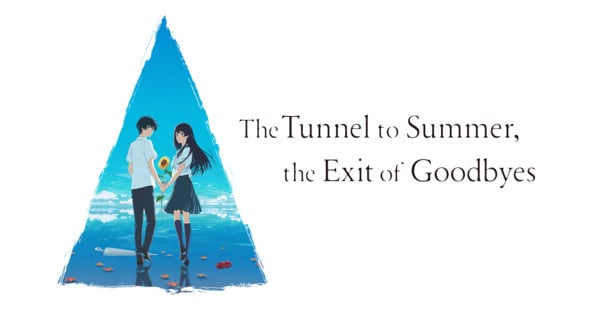Curated From www.animenewsnetwork.com Check Them Out For More Content.
The Tunnel to Summer, the Exit of Goodbyes is part of a growing genre of supernatural romance anime movies and follows many of its beats. A new person bursts into the protagonist’s life, bringing along with them a fantastical occurrence that serves as a symbol of a serious trauma in the protagonist’s life. The leads have to work together to solve the fantastical occurrence and, in doing so, become closer, tearing open old wounds and attempting to heal them. Comparisons to Shinkai movies are inevitable here–however, Tunnel to Summer is a movie that is well worth watching on its own terms, beautifully directed and achingly melancholy with aesthetic and storytelling flair.
One of the hallmarks of Taguchi’s directorial work is a stylish use of color, with striking monochromatic palettes that make any contrasting colors pop out, as we saw in both Akudama Drive and Bleach: Thousand-Year Blood War. Tunnel to Summer is no different, often using color for aesthetic and symbolic purposes. A rose-tinted world creates a sense of comfort but also unease, as if what we long for and hope for is unattainable. The tunnel is pitch black, and the falling leaves of the golden orange maple trees form gate-like structures, making even the most claustrophobic of spaces feel spacious and alive.
This tunnel is a liminal space, a place where characters must confront the violence of their past and their most painful attachments. Kaoru and Anzu are stuck in their pasts and aborted futures, trying to hang on to the memory and guilt over the death of dreams and loved ones. In the tunnel, faced with symbolic representations of their pain, they must choose what they hold onto and what they let go of as time stops for them and everybody else speeds far into the future. It is a bleak vision of arrested development, how the feeling of melancholic loss can consume a person and become what nourishes and drives them.
This sense of loss is not helped by the other thing that unites Anzu and Kaoru: a shared experience of emotional abuse from parents, which they process uniquely. Having been forced to give up her childhood dreams, Anzu remains stone-faced for most of the movie, uncomfortable with showing any signs of weakness or emotion whatsoever. Much of the pleasure of watching the movie is watching her slowly open up to Kaoru, particularly in her body language and character animation. When we first see her express genuine delight as Kaoru tells her he likes her work, it is so idiosyncratic and nuanced that it makes you fall in love with her. I don’t want to describe it so as not to spoil the moment, but it reveals so much: it seems that after so many years of being told what she cares about doesn’t matter, she doesn’t want to express joy at another person’s approval because to do so would be to give them too much power over her, so she immediately tries to hide it, even as she is slowly learning to trust that person.
On the other hand, Kaoru is wracked by a sense of grief and guilt that has led him to distance himself from everybody around him. His scenes with his father, whose abuse has contributed to his sense of guilt, are both empathetic and realistic, largely without being sensationalized. The scenes where his father attempts to make up with him after violent physical and emotional abuse and then immediately takes back any kind words when Kaoru does not reciprocate are chilling–there is a sense that this is a cycle that has happened before. In a way, this is also how the tunnel can serve as a symbol, representing how one withdraws from community to protect oneself as one attempts to survive an abusive situation.
It’s also worth noting that the film’s version of Kaoru is a marked improvement on his novel counterpart, who has somewhat of an edgelord streak. One of the benefits of a good light novel adaptation is the excising of my least favorite part of many light novels, the endless internal monologue. Perhaps it is fitting that the director Taguchi also wrote the screenplay adaptation, as Kaoru’s thoughts are far better conveyed through his masterful direction than an overbearing narration ever could. This comes out especially during a scene where Kaoru, pushed to the breaking point by his abusive father, has a panic attack. The use of the first-person camera during the attack, as well as the voice acting and sound design (which foregoes music during the scene), renders it respectfully, allowing the audience to enter the experience without feeling voyeuristic.
Even though they have similar circumstances, their responses to violence are markedly different. Anzu will take the first strike when confronted with a threat, while Kaoru has learned to run away to avoid confronting the violence he has experienced–both ways of coping largely keeping people at arm’s length. It would be quite simple to make the story about how Anzu has to let go of aggressively defending herself, and Kaoru has to learn to stop running away. Still, the arc of healing that these characters go down is more nuanced than that, more about fixing the roots of the problems these characters face than fixing their coping mechanisms for those problems.
In this respect, the most significant way the movie differs from the books is a slight letdown. Much of the book’s arc is about the two characters learning to let other people into their lives, not just each other. The significant limiting of the role of Kawasaki, the bully, and Shohei, Kaoru’s only friend, in the narrative makes their arc of healing less meaningful–as they are the two people through whom we come to most deeply understand the ways Kaoru and Anzu interact with the world around them outside of romantic relationships in the book. This is a shame because it cuts a considerable part of the healing process as a survivor: finding a support structure.
However, this is a relatively minor note about an otherwise strong film. I would be remiss not to mention the eclectic and precisely used soundtrack by Harumi Fuuki and the sound direction by Satoki Iida, which always conveys an intimate and atmospheric quality. Whether using unmetered gamelan during the tunnel scenes to create the sense of otherworldly multidimensional ritual, or the silences and subtle sound direction of the home scenes where Kaoru is forced to deal with the remnants of his past, the sound work in the film is stunning. It deserves all the praise I can give it. This is Fuuki’s best work to date.
The Tunnel to Summer, the Exit of Goodbyes is a beautiful depiction of two teenagers trying to muddle their way through abuse and grief, with stunning visuals, music, and a well-written script. I cannot wait to see what comes next from the pen and directorial eye of Taguchi-san, who, between this and Akudama Drive, now ranks among my favorite directors. Do yourself a favor and watch it.

